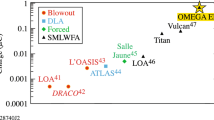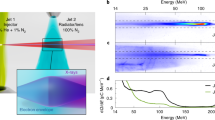Abstract
Extreme optical fluences, much beyond the damage threshold of conventional optics, are of interest for a range of high-energy-density physics applications. Nonlinear interactions of multiple beams in plasmas have the potential to produce optics that operate at much higher intensity and fluence than is possible in solids. In inertial confinement fusion experiments indirectly driven with lasers, many beams overlap in the plasma inside a hohlraum, and cross-beam energy transfer by Brillouin scattering has been employed to redistribute energy between laser beams within the target. Here, we show that in a hot, under-dense plasma the energy of many input beams can be combined into a single well-collimated beam. The emerging beam has an energy of 4 kJ (over 1 ns) that is more than triple that of any incident beam, and a fluence that is more than double. Because the optic produced is plasma, and is diffractive, it is inherently capable of generating higher fluences in a single beam than solid-state refractive or reflective optics.
This is a preview of subscription content, access via your institution
Access options
Access Nature and 54 other Nature Portfolio journals
Get Nature+, our best-value online-access subscription
$29.99 / 30 days
cancel any time
Subscribe to this journal
Receive 12 print issues and online access
$209.00 per year
only $17.42 per issue
Buy this article
- Purchase on Springer Link
- Instant access to full article PDF
Prices may be subject to local taxes which are calculated during checkout




Similar content being viewed by others
References
Basic Research Needs in HEDLP ReNeW 2011 (eds Rosner, R. & Hammer, D.) (US Department of Energy, 2011); https://nnsa.energy.gov/sites/default/files/nnsa/01-13-inlinefiles/Basic%20Research%20Needs%20in%20HEDLP-ReNeW-Download-opt_2011.pdf
Bude, J. et al. High fluence laser damage precursors and their mitigation in fused silica. Opt. Express 22, 5839–5851 (2014).
Perry, M. D. et al. Petawatt laser pulses. Opt. Lett. 24, 160–162 (1999).
Haynam, C. A. et al. National Ignition Facility laser performance status. Appl. Opt. 46, 3276–3303 (2007).
Boehly, T. R. et al. Initial performance results of the OMEGA laser system. Opt. Commun. 133, 495–506 (1997).
McKay, A., Spence, D. J., Coutts, D. W. & Mildren, R. P. Diamond-based concept for combining beams at very high average powers. Laser Photon. Rev. 11, 1600130 (2017).
Ren, J., Cheng, W., Li, S. & Suckewer, S. A new method for generating ultraintense and ultrashort laser pulses. Nat. Phys. 3, 732–736 (2007).
Mourou, G. A. et al. Exawatt-Zettawatt pulse generation and applications. Opt. Commun. 285, 720–724 (2012).
Shvets, G., Fisch, N. J., Pukhov, A. & Meyer-ter-Vehn, J. Superradiant amplification of an ultrashort laser pulse in a plasma by a counterpropagating pump. Phys. Rev. Lett. 81, 4879–4882 (1998).
Malkin, V. M., Shvets, G. & Fisch, N. J. Fast compression of laser beams to highly overcritical powers. Phys. Rev. Lett. 82, 4448–4451 (1999).
Fisch, N. J. & Malkin, V. M. Generation of ultrahigh intensity laser pulses. Phys. Plasmas 10, 2056–2063 (2003).
Ping, Y., Cheng, W., Suckewer, S., Clark, D. S. & Fisch, N. J. Amplification of ultrashort laser pulses by a resonant Raman scheme in a gas-jet plasma. Phys. Rev. Lett. 92, 175007 (2004).
Cheng, W. et al. Reaching the nonlinear regime of Raman amplification of ultrashort laser pulses. Phys. Rev. Lett. 94, 045003 (2005).
Ren, J. et al. A compact double-pass Raman backscattering amplifier/compressor. Phys. Plasmas 15, 056702 (2008).
Ping, Y. et al. Development of a nanosecond-laser-pumped Raman amplifier for short laser pulses in plasma. Phys. Plasmas 16, 123113 (2009).
Kirkwood, R. K. et al. Observation of amplification of light by Langmuir waves and its saturation on the electron kinetic timescale. J. Plasma Phys. 77, 521–528 (2011).
Yampolsky, N. A. & Fisch, N. J. Limiting effects on laser compression by resonant backward Raman scattering in modern experiments. Phys. Plasma 18, 056711 (2011).
Andreev, A. A. et al. Short light pulse amplification and compression by stimulated Brillouin scattering in plasmas in the strong coupling regime. Phys. Plasmas 13, 053110 (2006).
Weber, S. et al. Amplification of ultrashort laser pulses by Brillouin backscattering in plasmas. Phys. Rev. Lett. 111, 055004 (2013).
Lancia, L. et al. Signatures of the self-similar regime of strongly coupled stimulated Brillouin scattering for efficient short laser pulse amplification. Phys. Rev. Lett. 116, 075001 (2016).
Edwards, M. R., Jia, Q., Mikhailova, J. M. & Fisch, N. J. Short-pulse amplification by strongly coupled stimulated Brillouin scattering. Phys. Plasmas 23, 083122 (2016).
Jia, Q., Barth, I., Edwards, M. R., Mikhailova, J. M. & Fisch, N. J. Distinguishing Raman from strongly coupled Brillouin amplification for short pulses. Phys. Plasmas 23, 053118 (2016).
Lehmann, G. & Spatschek, K. H. Transient plasma photonic crystals for high-power lasers. Phys. Rev. Lett. 116, 225002 (2016).
Balakin, A. A., Fraiman, G. M., Fisch, N. J. & Malkin, V. M. Noise suppression and enhanced focusability in plasma Raman amplifier with multi-frequency pump. Phys. Plasmas 10, 4856–4864 (2003).
Kirkwood, R. K. et al. A review of laser-plasma interactions physics of indirect drive fusion plasma. Phys. Control. Fusion 55, 103001 (2013).
Dewald, E. et al. Early-time symmetry tuning in the presence of cross-beam energy transfer in ICF experiments on the national ignition facility. Phys. Rev. Lett. 111, 235001 (2013).
Turnbull, D. P. et al. Multibeam seeded Brillouin sidescatter in inertial confinement fusion experiments. Phys. Rev. Lett. 114, 125001 (2015).
Hurricane, O. A. et al. Fuel gain exceeding unity in an inertially confined fusion implosion. Nature 506, 343–348 (2014).
Meezan, N. B. et al. Indirect drive ignition at the National Ignition Facility. Plasma Phys. Control. Fusion 59, 014021 (2017).
Chaves, J. Introduction to Nonimaging Optics 2nd edn (CRC Press, 2015).
Fournier, K. B. et al. A geophysical shock and air blast simulator at the National Ignition Facility. Rev. Sci. Instrum. 85, 095119 (2014).
Kruer, W. L., Wilks, S. C., Afeyan, B. B. & Kirkwood, R. K. Energy transfer between crossing laser beams. Phys. Plasmas 3, 382–385 (1996).
Berger, R. L. et al. On the dominant and subdominant behavior of stimulated Raman and Brillouin scattering driven by nonuniform laser beams. Phys. Plasmas 5, 4337–4356 (1998).
Marinak, M. M. et al. Three-dimensional HYDRA simulations of National Ignition Facility targets. Phys. Plasmas 8, 2275–2280 (2001).
Gbur, G. & Wolf, E. The Rayleigh range of partially coherent beams. Opt. Commun. 199, 295–304 (2001).
Kirkwood, R. K. et al. Implementation and optimization of a plasma beam combiner at NIF. Bull. Am. Phys. Soc. http://meetings.aps.org/link/BAPS.2015.DPP.UP12.21 (2015).
Williams, E. A. On the control of filamentation of intense laser beams propagating in underdense plasma. Phys. Plasmas 13, 056310 (2006).
Williams, E. A. et al. Effects of ion trapping on crossed-laser-beam stimulated Brillouin scattering. Phys. Plasmas 11, 231–244 (2004).
Michel, P. et al. Tuning the implosion symmetry of ICF targets via controlled crossed-beam energy transfer. Phys. Rev. Lett. 102, 025004 (2009).
Kirkwood, R. K. et al. Amplification of light in a plasma by stimulated ion acoustic waves driven by multiple crossing pump beams. Phys. Rev. E 84, 026402 (2011).
Turnbull, D. P. et al. Refractive index seen by a probe beam interacting with a laser-plasma system. Phys. Rev. Lett. 118, 015001 (2017).
Kirkwood, R. K. et al. Observation of saturation of energy transfer between copropagating beams in a flowing plasma. Phys. Rev. Lett. 89, 215003 (2002).
Kirkwood, R. K. et al. Saturation of power transfer between two copropagating laser beams by ion-wave scattering in a single-species plasma. Phys. Plasmas 12, 112701 (2005).
Town, R. P. J. et al. Analysis of the National Ignition Facility ignition hohlraum energetics experiments. Phys. Plasmas 18, 056302 (2011).
Michel, P. et al. Saturation of multi-laser beams laser-plasma instabilities from stochastic ion heating. Phys. Plasmas 20, 056308 (2013).
Williams, E. et al. The frequency and damping of ion acoustic waves in hydrocarbon (CH) and two-ion-species plasmas. Phys. Plasmas 2, 129–138 (1995).
Michel, P. et al. Three-wavelength scheme to optimize hohlraum coupling on the National Ignition Facility. Phys. Rev. E 83, 046409 (2011).
Moody, J. D. et al. Multi-step redirection of ultra high power lasers in a plasma. Nat. Phys. 8, 344–349 (2012).
Niemann, C. et al. Stimulated forward Raman scattering in large scale-length laser-produced plasmas. J. Inst. 6, P10008 (2011).
Pickworth, L. A. et al. Determination of the laser intensity applied to a Ta witness plate from the measured X-ray signal using a pulsed micro-channel plate detector. High Energy Density Phys. 23, 159–166 (2017).
Maddox, B. R. et al. High-energy X-ray backlighter spectrum measurements using calibrated image plates. Rev. Sci. Instrum. 82, 023111 (2011).
Zimmerman, G. & Kruer, W. The Lasnex code for intertial confinement fusion. Comments Plasma Phys. Control. Fusion 2, 85–90 (1975).
Acknowledgements
The authors are indebted to the staff of the NIF laser facility for carrying out these experiments and insuring that a large number of detailed requirements of the experiments were met, as well as to B. Wallin and K. Budil for their encouragement of this work. R.K.K. gratefully acknowledges the contributions of R. L. Berger in performing the kinetic calculations of the parameters in used in equation (1), and the help of M. M. Marinak in carrying out the Hydra simulations shown in Fig. 4.
Author information
Authors and Affiliations
Contributions
The concept for the beam combiner design we describe was formulated and its design carried out by R.K.K., R.A.L., S.C.W., K.B.F., D.P.T. and W.H.D. The development of the technique to measure the transmitted beam properties was done by R.K.K., D.P.T., L.A.P., O.L.L., J.D.M. and M.D.R. The final phase of implementation and integration with the NIF laser facility was carried out by R.K.K., S.C.W., D.P.T., L.A.P., T.C., L.D., P.A.M., J.D.M., O.L.L., D.J.S., B.J.M., B.M.V.W. and B.E.B., which included assessments of likely output beam performance for its impact on the facility and optimally integrating the experimental requirements with other facility demands. Actual execution of experiments was carried out by D.P.T., R.K.K. and L.A.P. Post experimental pF3D simulations were carried out by T.C., L.D. and P.A.M., and final revisions of the manuscript were considered by all authors.
Corresponding author
Ethics declarations
Competing interests
The authors declare no competing financial interests.
Rights and permissions
About this article
Cite this article
Kirkwood, R., Turnbull, D., Chapman, T. et al. Plasma-based beam combiner for very high fluence and energy. Nature Phys 14, 80–84 (2018). https://doi.org/10.1038/nphys4271
Received:
Accepted:
Published:
Issue Date:
DOI: https://doi.org/10.1038/nphys4271
This article is cited by
-
Intense isolated attosecond pulses from two-color few-cycle laser driven relativistic surface plasma
Scientific Reports (2022)
-
New criteria for efficient Raman and Brillouin amplification of laser beams in plasma
Scientific Reports (2020)
-
Impact of the Langdon effect on crossed-beam energy transfer
Nature Physics (2020)



